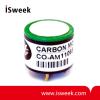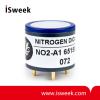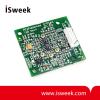Electrochemical Phosphine Gas Sensor (PH3 Sensor) - 4PH-Fast CiTiceL
• Operating Principle: 3-electrode electrochemical
• Measurement Range: 0-5 ppm PH3
• Maximum Overload: 20 ppm PH3
• Resolution (Electronics dependent): < 0.05 ppm
• Sensitivity: 1.7 ± 0.3 µA/ppm
• Response Time (T90): < 60 seconds
• Repeatability: 2% of signal
• Operating Temperature Range: -20°C to +50°C
• Operating Humidity Range: 15% to 90% RH non-condensing
- Quantity:
- - +
Product Specification
4PH-Fast CiTiceL Phosphine Sensor (PH3 Sensor) Key Features & Benefits:
• Industry leading reliability
• Improved performance variability
4PH-Fast CiTiceL Phosphine Sensor (PH3 Sensor) Technical Specifications
| MEASUREMENT | |
| Operating Principle | 3-electrode electrochemical |
| Measurement Range | 0-5 ppm PH3 |
| Maximum Overload | 20 ppm PH3 |
| Resolution (Electronics dependent) | < 0.05 ppm |
| Filter | None |
| Sensitivity* | 1.7 ± 0.3 µA/ppm |
| Response Time (T90)* | < 60 seconds |
| Baseline Offset (clean air)* | -0.05 to +0.2 ppm equivalent |
| Zero Shift (+20°C to +40°C) | < 0.07 ppm equivalent |
| Repeatability | 2% of signal |
| Linearity | Linear |
| ELECTRICAL | |
| Recommended Load Resistor | 10 Ω |
| Bias Voltage | Not required |
| MECHANICAL | |
| Housing Material | ABS |
| Weight | 5g (approx.) |
| Orientation | Any |
| ENVIRONMENTAL | |
| Operating Temperature Range | -20°C to +50°C |
| Operating Pressure Range | 1 atm ± 10% |
| Operating Humidity Range | 15% to 90% RH non-condensing |
| LIFETIME | |
| Long Term Output Drift | < 2% signal drift / month |
| Recommended Storage Temp | 0 to 20°C |
| Expected Operating Life | 2 years in air |
| Storage Life | 6 months in sealed container |
* Specifications are valid at 20°C, 50% RH and 1013 mBar, using City Technology recommended circuitry. Performance characteristics outline the performance of sensors supplied within the first 3 months. Output signal can drift below the lower limit over time.
Poisoning
CiTiceLs are designed for operation in a wide range of environments and harsh conditions. However, it is important that exposure to high concentrations of solvent vapours is avoided, both during storage, fitting into instruments, and operation.
When using sensors with printed circuit boards (PCBs), degreasing agents should be used before the sensor is fitted. Do not glue directly on or near the CiTiceL as the solvent may cause crazing of the plastic.
If you cannot find what you want, you can entrust OFweek to source for you. Just click:
Sourcing ServiceRecommended Products
-

Electrochemical carbon monoxide sensor CO
-

Carbon Monoxide Sensor (CO Sensor)
-

Hydrogen Cyanide Sensor (HCN Sensor)
-

Phosphine Sensor (PH3 Sensor)
-

Nitric Oxide Sensor (NO Sensor)
-

Nitrogen Dioxide Sensor (NO2 Sensor)
-

Infrared Carbon Dioxide (CO2) Sensor Pyroelectric Detector
-

Ethylene Oxide Sensor (ETO Sensor)
-

Individual Sensor Board (ISB) Alphasense B4 4-Electrode Gas Sensors
-

Hydrogen Chloride Sensor (HCL Sensor)
















